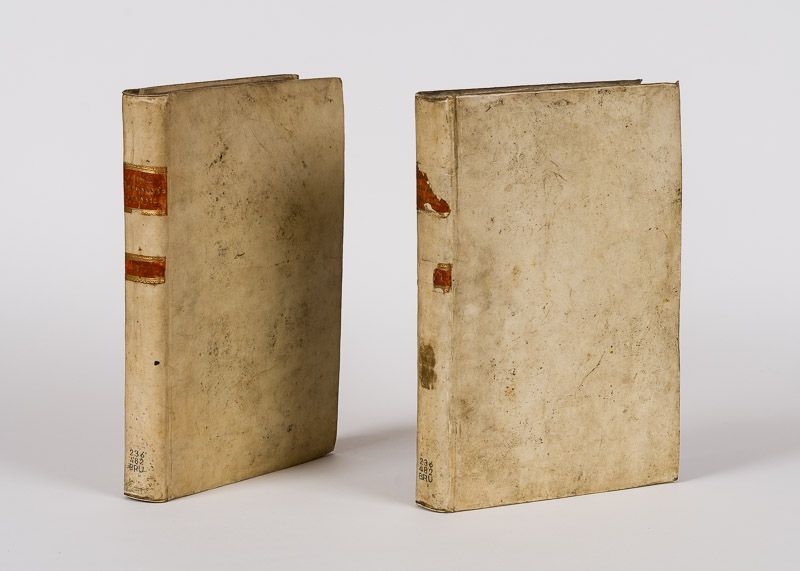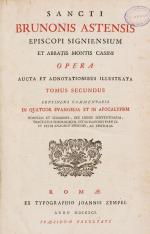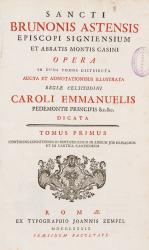Bruno, Opera. [Sancti Brunonis Astensi Episcopi Signiensium et Abbatis Montis Ca
Opera. [Sancti Brunonis Astensi Episcopi Signiensium et Abbatis Montis Casini Opera in Duos Tomos Distributa aucta et Adnotationibus Illustrata Regiae Celsitudini Caroli Emmanuelis Pedemontii Principis &c. &c.].
Romae, Joannis Zempel, 1789-1791. Folio. C, 634, XXXVII, 688, III pages. Hardcover / Original parchment with gilt lettering on spine Former copy of St.Joseph’s College / Mill Hill Library.
Brunonis Astensis – (ca. 1040/1050-1123)
Initial studies at the Benedictine monastery of S. Perpetua in Asti, where he studied humanities and prepared for the ecclesiastical life; then, he went to study the seven liberal arts at the University of Bologna. He decided to enter the monastery of Monte Cassino but during the trip, he became ill in Siena and the local bishop, Rodolfo, named him canon of the cathedral chapter. Because of his knowledge and piety, he was called to Rome, where he was advisor to four popes. Participated in a Roman synod in 1079; there, he convinced Berengarius of Tours to retract his heresy which denied the real presence of the Lord in the Holy Eucharist; the disputation between the canon and the heretic took place before Pope Gregory VII. Elected bishop of Segni in 1079 (2) by its canons; he accepted after an intervention of Pope Gregory VII. Consecrated in 1080, Campagna of Rome, by Pope Gregory VII. In 1082, returning to Segni from Rome, he was imprisoned by Adolfo di Segni; tradition says that he was miraculously freed. Returned to Rome and there he was imprisoned, together with the pope in mole Adriana (castle of Sant’Angelo). Librarian and chancellor of the Holy Roman Church in 1086.
Created cardinal bishop of Segni in a consistory celebrated in 1086 (3). Participated in the papal election of 1088, celebrated in Terracina, in which Pope Urban II was elected. Subscribed papal bulls issued between 1089 and July 20, 1096. In 1095, he accompanied Pope Urban II to the Council of Clermont, in which the First Crusade was called; he went with the pontiff to Avignon Tarasco on September 11, 1095; to Avignon on September 13; to Cluny on October 25; to Clermont on November 18 (he participated in the council celebrated in that city); to Limoges, December 23 to 31; to Charroux, where he participated in the consecration of the abbatial church, on January 10, 1096; to Poitiers on January 22; to Moyenmoutier on March 10; to Tours on March 14 to 20 (he participated in the council celebrated in that city); to Poitiers from March 30 and before April 14; to Nîmes on July 12; and to St.-Gilles on July 20. Did not participate in the papal election of 1099, in which Pope Paschal II was elected. Subscribed papal bulls issued between August 30, 1100 and November 2, 1106. In 1103, he entered the Order of Saint Benedict (Benedictines) at the monastery of Monte Cassino; he was elected abbot in November 1107, keeping his episcopal see. He was sent to France as legate in 1104. In March 1105, during the Lateran Synod, he acted as a judge in a controversy. On September 8 of the same year, he was with the pope in Civita Castellana. He returned to France as legate in 1106. On November 2, 1106, he was in Parma with the pope. On June 4, 1109, Pope Paschal II went to Segni to canonize Bishop Pietro of Anagni, friend of Cardinal Bruno, and most probably, the cardinal was present at the ceremony. He opposed lay investitures of bishops and abbot, even declaring them to be heresy; he criticized Pope Paschal II for granting Emperor Heinrich the privilege of investitures during the pontiff’s imprisonment by the emperor April 11, 1111 and demanded that the treaty be annulled. On March 23, 1112, during the Lateran Synod, Pope Paschal II rejected the granting of the privilege of investitures to Emperor Heinrich V; the bishop of Segni was not present at that session of the synod and he continued with his intransgent position; unhappy with the bishop’s opposition, the pope asked him resign his abbey and to return to his see of Segni definitively. He participated in the Lateran synod of 1116, but never regained his earlier position in the papal curia. He wrote commentaries on thirteen books of the Holy Bible; a life of Pope St. Leo IX; and one of St. Pietro, bishop of Anagni; a treatise on the Sacraments; and another one on the Holy Sacrifice of the Mass; 145 of his homilies and six books of sentences are still preserved. (Source: The Cardinals of the Holy Roman Church – Biographical Dictionary).
- Keywords: 18th Century – Rare · Catalogue No.7 – Religion · Rare Books · Religion – Rare
- Language: Deutsch
- Inventory Number: 25721AB
EUR 780,--
© 2025 Inanna Rare Books Ltd. | Powered by HESCOM-Software













